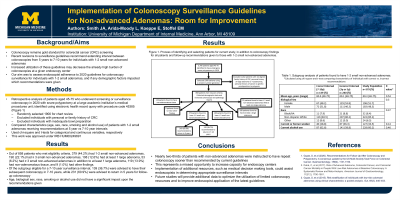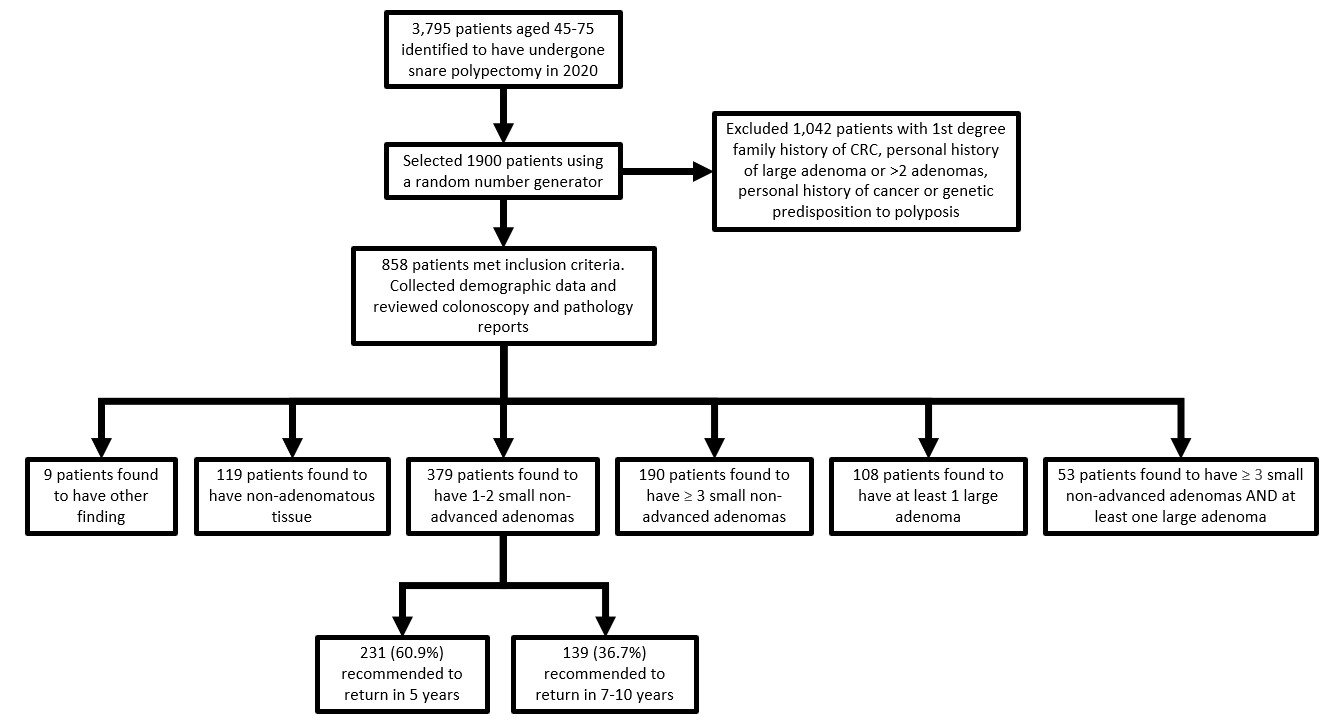Sunday Poster Session
Category: Colorectal Cancer Prevention
P0400 - Implementation of Colonoscopy Surveillance Guidelines for Non-Advanced Adenomas: Room for Improvement
Sunday, October 27, 2024
3:30 PM - 7:00 PM ET
Location: Exhibit Hall E

Has Audio

Joshua Smith, MD
University of Michigan
Ann Arbor, MI
Presenting Author(s)
Joshua Smith, MD, Liliana Arida-Moody, BS, Erika Koeppe, MS, BS, Elena Stoffel, MD, MPH
University of Michigan, Ann Arbor, MI
Introduction: Colonoscopy remains the gold standard for colorectal cancer screening due to its capacity to directly visualize and remove precancerous lesions. Recent revisions to surveillance guidelines recommend extending the interval between colonoscopies from 5 years to 7-10 years for individuals with 1-2 small non-advanced adenomas. We sought to evaluate whether endoscopists are applying these new guidelines uniformly across patients.
Methods: Patients aged 45-75 who underwent a colonoscopy with polyp removal at an academic medical center during calendar year 2020 were identified using an electronic health record query using procedure code 45385 (colonoscopy with removal of polyp by snare). A random number generator was used to select approximately half of this cohort (1900 patients) for chart review. Patients were excluded if bowel preparation was inadequate, colonoscopy or polypectomy was incomplete, reason for colonoscopy was diagnostic, or if the individual had a predisposing reason for requiring more frequent colonoscopies. 858 patients met inclusion criteria. We compared characteristics of patients who received a recommendation for 5 year vs 7-10 year colonoscopy interval.
Results: A total of 3,795 patients who had colonoscopy with snare polypectomy were identified. After applying exclusion criteria, of the 858 individuals studied, 456 (53.1%) were male, 402 (46.9%) were female, and average age was 60.8. 190 had ≥ 3 small non-advanced adenomas, 108 patients had at least 1 large adenoma, 53 patients had ≥ 3 small non-advanced adenomas in addition to at least 1 large adenoma, 119 patients had non-adenomatous tissue, and 9 patients had other findings. 379 (44.2%) were found to have 1-2 small non-advanced adenomas. Of this subgroup, 139 (36.7%) were advised to have their subsequent colonoscopy in 7-10 years, while 231 (60.9%) were advised to return in 5 years for follow-up surveillance colonoscopy (Figure 1). Age, sex, race, smoking or alcohol use did not have a significant difference upon the recommendations given (Table 1).
Discussion: Nearly 2 in 3 patients with non-advanced adenomas are recommended to return sooner than current guidelines propose. This represents a missed opportunity to increase capacity for colonoscopies. Implementation of additional resources, such as medical decision making tools, could assist endoscopists in determining appropriate surveillance intervals. Ongoing prospective studies will provide additional data to optimize utilization of limited colonoscopy resources.

Note: The table for this abstract can be viewed in the ePoster Gallery section of the ACG 2024 ePoster Site or in The American Journal of Gastroenterology's abstract supplement issue, both of which will be available starting October 27, 2024.
Disclosures:
Joshua Smith, MD, Liliana Arida-Moody, BS, Erika Koeppe, MS, BS, Elena Stoffel, MD, MPH. P0400 - Implementation of Colonoscopy Surveillance Guidelines for Non-Advanced Adenomas: Room for Improvement, ACG 2024 Annual Scientific Meeting Abstracts. Philadelphia, PA: American College of Gastroenterology.
University of Michigan, Ann Arbor, MI
Introduction: Colonoscopy remains the gold standard for colorectal cancer screening due to its capacity to directly visualize and remove precancerous lesions. Recent revisions to surveillance guidelines recommend extending the interval between colonoscopies from 5 years to 7-10 years for individuals with 1-2 small non-advanced adenomas. We sought to evaluate whether endoscopists are applying these new guidelines uniformly across patients.
Methods: Patients aged 45-75 who underwent a colonoscopy with polyp removal at an academic medical center during calendar year 2020 were identified using an electronic health record query using procedure code 45385 (colonoscopy with removal of polyp by snare). A random number generator was used to select approximately half of this cohort (1900 patients) for chart review. Patients were excluded if bowel preparation was inadequate, colonoscopy or polypectomy was incomplete, reason for colonoscopy was diagnostic, or if the individual had a predisposing reason for requiring more frequent colonoscopies. 858 patients met inclusion criteria. We compared characteristics of patients who received a recommendation for 5 year vs 7-10 year colonoscopy interval.
Results: A total of 3,795 patients who had colonoscopy with snare polypectomy were identified. After applying exclusion criteria, of the 858 individuals studied, 456 (53.1%) were male, 402 (46.9%) were female, and average age was 60.8. 190 had ≥ 3 small non-advanced adenomas, 108 patients had at least 1 large adenoma, 53 patients had ≥ 3 small non-advanced adenomas in addition to at least 1 large adenoma, 119 patients had non-adenomatous tissue, and 9 patients had other findings. 379 (44.2%) were found to have 1-2 small non-advanced adenomas. Of this subgroup, 139 (36.7%) were advised to have their subsequent colonoscopy in 7-10 years, while 231 (60.9%) were advised to return in 5 years for follow-up surveillance colonoscopy (Figure 1). Age, sex, race, smoking or alcohol use did not have a significant difference upon the recommendations given (Table 1).
Discussion: Nearly 2 in 3 patients with non-advanced adenomas are recommended to return sooner than current guidelines propose. This represents a missed opportunity to increase capacity for colonoscopies. Implementation of additional resources, such as medical decision making tools, could assist endoscopists in determining appropriate surveillance intervals. Ongoing prospective studies will provide additional data to optimize utilization of limited colonoscopy resources.

Figure: Figure 1. Process of identifying and selecting patients for current study, in addition to colonoscopy findings for all patients and follow-up recommendations given to those with 1-2 small non-advanced adenomas.
Note: The table for this abstract can be viewed in the ePoster Gallery section of the ACG 2024 ePoster Site or in The American Journal of Gastroenterology's abstract supplement issue, both of which will be available starting October 27, 2024.
Disclosures:
Joshua Smith indicated no relevant financial relationships.
Liliana Arida-Moody indicated no relevant financial relationships.
Erika Koeppe indicated no relevant financial relationships.
Elena Stoffel indicated no relevant financial relationships.
Joshua Smith, MD, Liliana Arida-Moody, BS, Erika Koeppe, MS, BS, Elena Stoffel, MD, MPH. P0400 - Implementation of Colonoscopy Surveillance Guidelines for Non-Advanced Adenomas: Room for Improvement, ACG 2024 Annual Scientific Meeting Abstracts. Philadelphia, PA: American College of Gastroenterology.
